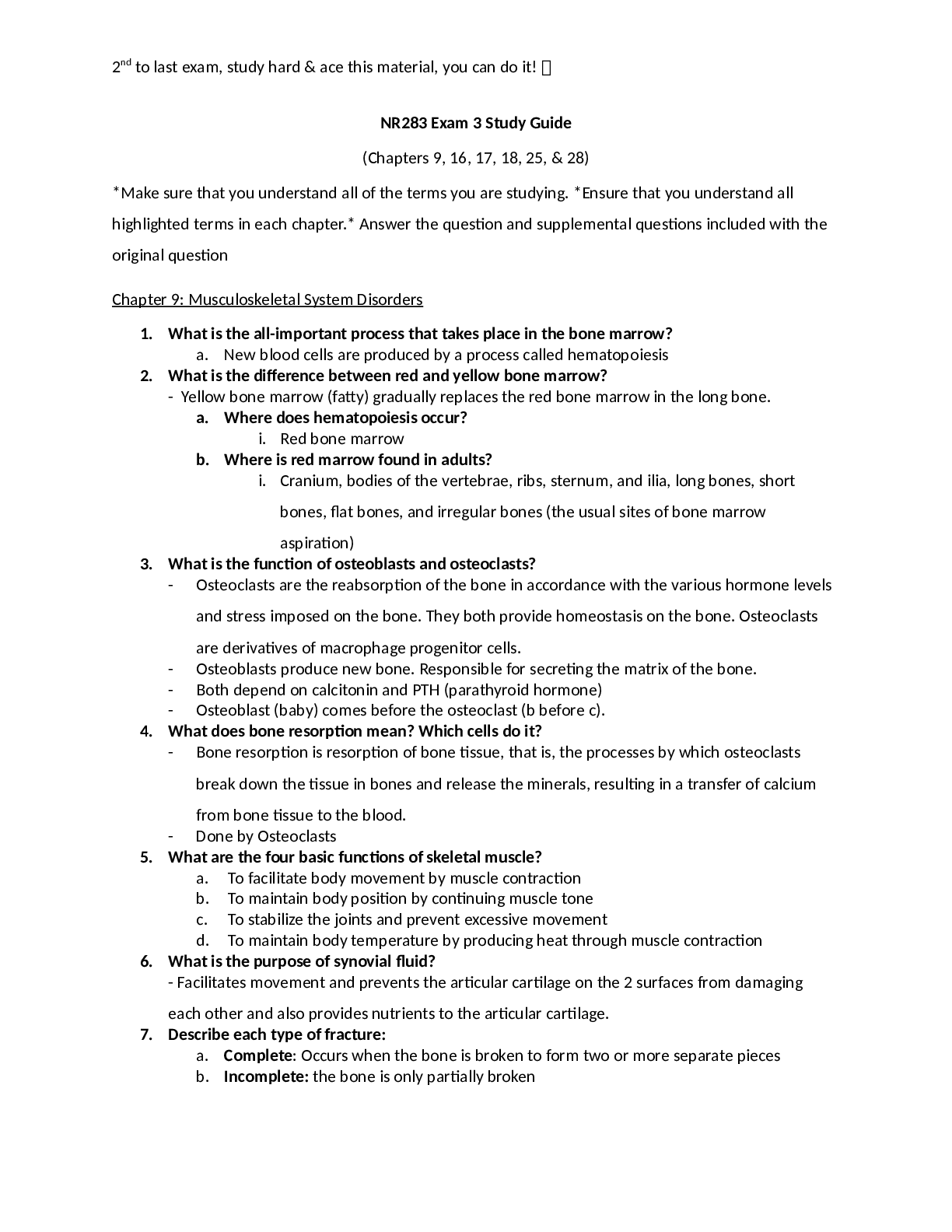NR283 Exam 3 Study Guide
(Chapters 9, 16, 17, 18, 25, & 28)
*Make sure that you understand all of the terms you are studying. *Ensure that you understand all
highlighted terms in each chapter.* Answer the question and supplemental questions included with the
original question
Chapter1.2.3.4.5.6.7.9: Musculoskeletal System Disorders
What is the all-important process that takes place in the bone marrow?
a. New blood cells are produced by a process called hematopoiesis
What is the difference between red and yellow bone marrow?
- Yellow bone marrow (fatty) gradually replaces the red bone marrow in the long bone.
a. Where does hematopoiesis occur?
i. Red bone marrow
b. Where is red marrow found in adults?
i. Cranium, bodies of the vertebrae, ribs, sternum, and ilia, long bones, short
bones, flat bones, and irregular bones (the usual sites of bone marrow
aspiration)
What is the function of osteoblasts and osteoclasts?
- Osteoclasts are the reabsorption of the bone in accordance with the various hormone levels
and stress imposed on the bone. They both provide homeostasis on the bone. Osteoclasts
are derivatives of macrophage progenitor cells.
- Osteoblasts produce new bone. Responsible for secreting the matrix of the bone.
- Both depend on calcitonin and PTH (parathyroid hormone)
- Osteoblast (baby) comes before the osteoclast (b before c).
What does bone resorption mean? Which cells do it?
- Bone resorption is resorption of bone tissue, that is, the processes by which osteoclasts
break down the tissue in bones and release the minerals, resulting in a transfer of calcium
from bone tissue to the blood.
- Done by Osteoclasts
What are the four basic functions of skeletal muscle?
a. To facilitate body movement by muscle contraction
b. To maintain body position by continuing muscle tone
c. To stabilize the joints and prevent excessive movement
d. To maintain body temperature by producing heat through muscle contraction
What is the purpose of synovial fluid?
- Facilitates movement and prevents the articular cartilage on the 2 surfaces from damaging
each other and also provides nutrients to the articular cartilage.
Describe each type of fracture:
a. Complete: Occurs when the bone is broken to form two or more separate pieces
b. Incomplete: the bone is only partially broken
2nd to last exam, study hard & ace this material, you can do it!
8.9.10.c. Open: results when skin is broken. Bone fragments may be angles and protrude through
the skin. More damage to soft tissue, including the blood vessels and nerves. Higher risk
d.e.for infection.
Closed: The skin is not broken at the fracture site.
Simple: A single break in the bone in which the bone ends maintain their alignment and
f.g.position.
Comminuted: There are multiple fracture lines and bone fragments.
Compression: Common in the vertebrae, occurring when a bone is crushed or collapses
h.into small pieces.
Impacted: Occurs when one end of the bone is forced or telescoped into the adjacent
i.
bone; for example, the neck of the femur is crushed against the pelvis
Pathologic: Results from a weakness in the bone structure. The break occurs
j.
spontaneously or with very little stress on the bone.
i. What is a common disease that is the cause of a pathologic fracture?
1. Osteoporosis or tumors
Stress: (fatigue fractures) results from repeated excessive stress, commonly in the tibia,
femur, or second and third metatarsals.
i. What type of sport would this be common in?
1. Track and field, basketball, tennis, ballet and gymnastics
k. Depressed: Occurs in the skull when the broken section is forced inward on the brain.
l. Transverse: A fracture across the bone.
m. Linear: A break along the axis of the bone.
n. Oblique: A break at an angle to the diaphysis of the bone.
o. Spiral: A break that angles around the bone, usually due to a twisting injury.
What are the factors that affect healing of the bone?
- Muscle spasms, infection, ischemia, compartment syndrome (Extensive inflammation after
crushing injury), fat emboli (fatty marrow escapes the bone marrow into a vein, occurs
within first week after injury), Nerve damage, failure to heal (nonunion) or healing with
deformity (malunion), fractures in or near the joint.
What are the clinical manifestations of a fracture?
-Pain usually occurs immediately after an injury. In compound or multiple fractures pain is
delayed when the nerve function at the site is lost temporarily. Pain may cause shock
(tachycardia), and hypertension. Nausea and vomiting may occur.
a. What is crepitus?
i. A grating sound, may be heard if the ends of the bone fragments move over
each other (the limb should not be moved to test for this)
What is the treatment of a fracture?
- Immediate splinting and immobilization of the fracture site to reduce risk of complications.
- If necessary, reduction of the fracture is performed to restore bones to normal position.
a. What does open reduction mean?
Read More
.png)

